Chapter 1 Introduction¶
Abstract
- Database Systems
- Database Applications
- Purpose of Database Systems
- View of Data
- Data Models
- Database Languages
- Database Design
- Database Engine
- Database Users and Administrators
- History of Database Systems
Database Systems¶

DBMS
- Database is a collection of interrelated data about a enterprise, which is managed by a DBMS(Database Management System).
- The primary goal of a DBMS is to provide a way to store and retrieve database information that is both convenient and efficient.
- Management of data involves both defining structures for storage of information and providing mechanisms for the manipulation of information.
- The database system must ensure the safety of the information stored, despite system crashes or attempts at unauthorized access.
- If data are to be shared among several users, the system must provide concurrency control mechanisms to avoid possible anomalous results.
Difference Between File processor and DBMS
- A file-processing system can only coordinate physical access of data, while a DBMS can coordinate both phisical and logical access.
- A file-processing system only allow accessing data through the way determined in advance, while a DBMS allow doing this flexibly.
- A file-processing system allows multiple programs access diffrent data at the same time, or 2 programs access the same file at the same time if they both have read-only access to it. On the contrary, a DBMS allows multiple users accessing the same data at the same time.
- In a file-processing system, a file written by one program may be unreadable for another program. But in a DBMS, data duplications are reduced by make the data physically available to all the programs possessing access to it.
Purpose of Database Systems¶
In the early days, database applications were built directly on top of file systems,which leads to:
-
Data redundancy(数据冗余)and inconsistency(不一致)
- Multiple file formats, duplication of information in different files
-
Data isolation(数据孤立,数据孤岛) — multiple files and formats
-
Difficulty in accessing data (存取数据困难)
- Need to write a new program to carry out each new task
-
Integrity Problem(完整性问题)
Info
- Integrity constraints become “buried” in program code rather than being stated explicitly(显式的),数据与约束条件存储在此程序中,不是显式的
- Example: “account balance >=1”
- Hard to add new constraints or change existing ones
- Atomicity problems(原子性问题)
Example
- Transfer of funds from one to another(转账问题)
- Failures may leave database in an inconsistent state with partial updates carried out
- Concurrent access anomalies(并发访问异常)
Example
- Concurrent access needed for performance
- Uncontrolled concurrent accesses can lead to inconsistencies
- Example: Two people reading a balance (say 100) and updating it by saving money (say 50 each) at the same time
- Security Problems(安全性问题)
Example
- 银行审计(Audit)
- 权限(Privilege)
Characteristics of DataBases¶
Abstract
- data persistence(数据持久性)
- convenience in accessing data(数据访问便利性)
- data integrity (数据完整性)
- concurrency control for multiple users(多用户并发控制)
- failure recovery(故障恢复)
- security control(安全控制)
Data Models¶
-
A collection of tools for describing
- Data (数据)
- Data relationships(联系)
- Data semantics(语义)
- Data constraints(约束)
-
Relational Model(关系模型)
- Object-based data models
- Object-oriented (面向对象数据模型)
- Object-relational(对象-关系模型模型)
- Semistructured data model (XML)(半结构化数据模型)
- Other older models:
- Network model (网状模型)
- Hierarchical model(层次模型)
- Entity-Relationship Model(实体联系模型)
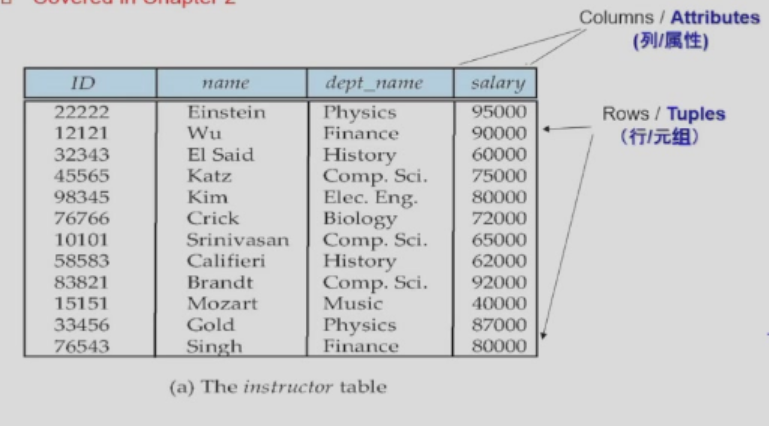
这里ID可以确定一行,称之为key
View of data¶
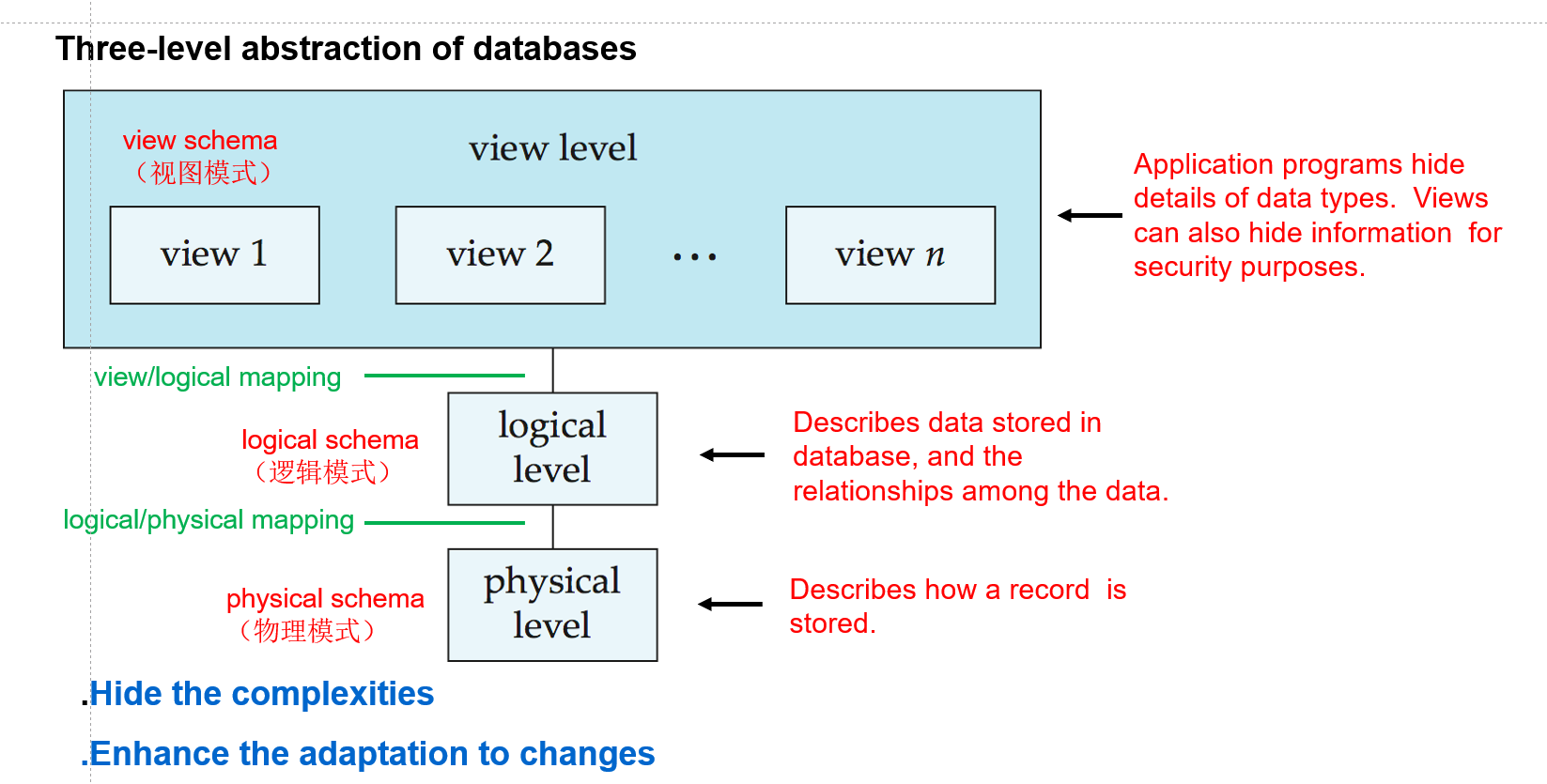
View of data
- 物理模式:描述数据如何存储
- 逻辑模式:描述了存储的数据以及之间关系
- 视图模式:应用程序出于安全等目的隐藏了大量细节,且是多样的
目的
- Hide the complexities(隐藏复杂性)
- Enhance the adaptation to changes(增强适应性)
Schema and Instance¶
- Similar to types and variables in programming languages
- Logical Schema(逻辑模式)– the logical structure of the database
- Example: The database consists of information about a set of customers and accounts and the relationship between them
- Analogous to type information of a variable in a program
- Physical schema (物理模式) – the overall physical structure of the database
- Instance(实例) – the actual content of the database at a particular point in time Analogous to the value of a variable
Data Independence¶
-
Physical Data Independence(物理数据独立性)– the ability to modify the physical schema without changing the logical schema
- Applications depend on the logical schema
- In general, the interfaces between the various levels and components should be well defined so that changes in some parts do not seriously influence others.
-
Logical Data Independence(逻辑数据独立性) – the ability to modify the logical schema without changing the user view schema
Database Languages¶
Abstract
- Data Definition Language (DDL)
- Data Manipulation Language (DML)
- SQL Query Language
- Application Program Interface (API)
Data Definition Language (DDL)(数据定义语言)¶
Specification notation for defining the database schema Example:
create table instructor (
ID char(5),
name varchar(20),
dept_name varchar(20),
salary numeric(8,2)
);
- DDL compiler generates a set of table templates stored in a data dictionary(数据字典)
- Data dictionary contains metadata (元数据, i.e., data about data)
- Database schema
- Integrity constraints(完整性约束)
- Primary key (ID uniquely identifies instructors)(主健)
- Referential integrity (references constraint in SQL)(参照完整性)
- e.g. dept_name value in any instructor tuple must appear in department relation
- Authorization(权限)
- 常用的语句关键字有 CREATE、DROP、ALTER 等
Example
Data Manipulation Language (DML)(数据操作语言)¶
- Language for accessing and manipulating the data organized by the appropriate data model
- DML also known as query language
- Two classes of languages
- Procedural(过程式) – user specifies what data is required and how to get those data
- Declarative (nonprocedural, 陈述式,非过程式) – user specifies what data is required without specifying how to get those data
- SQL is the most widely used query language
Example
SQL Query Language¶
SQL: widely used non-procedural language
Example
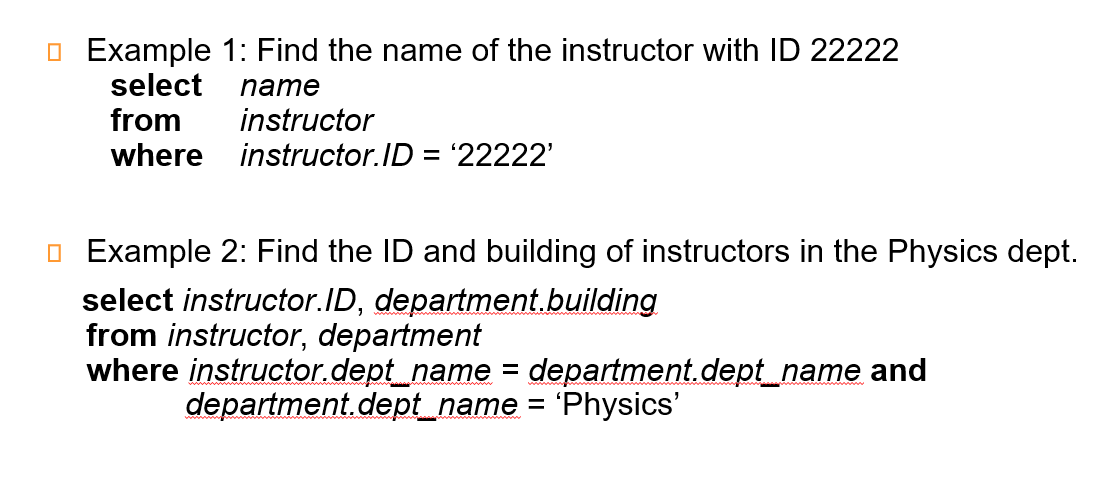
DataBase Design¶
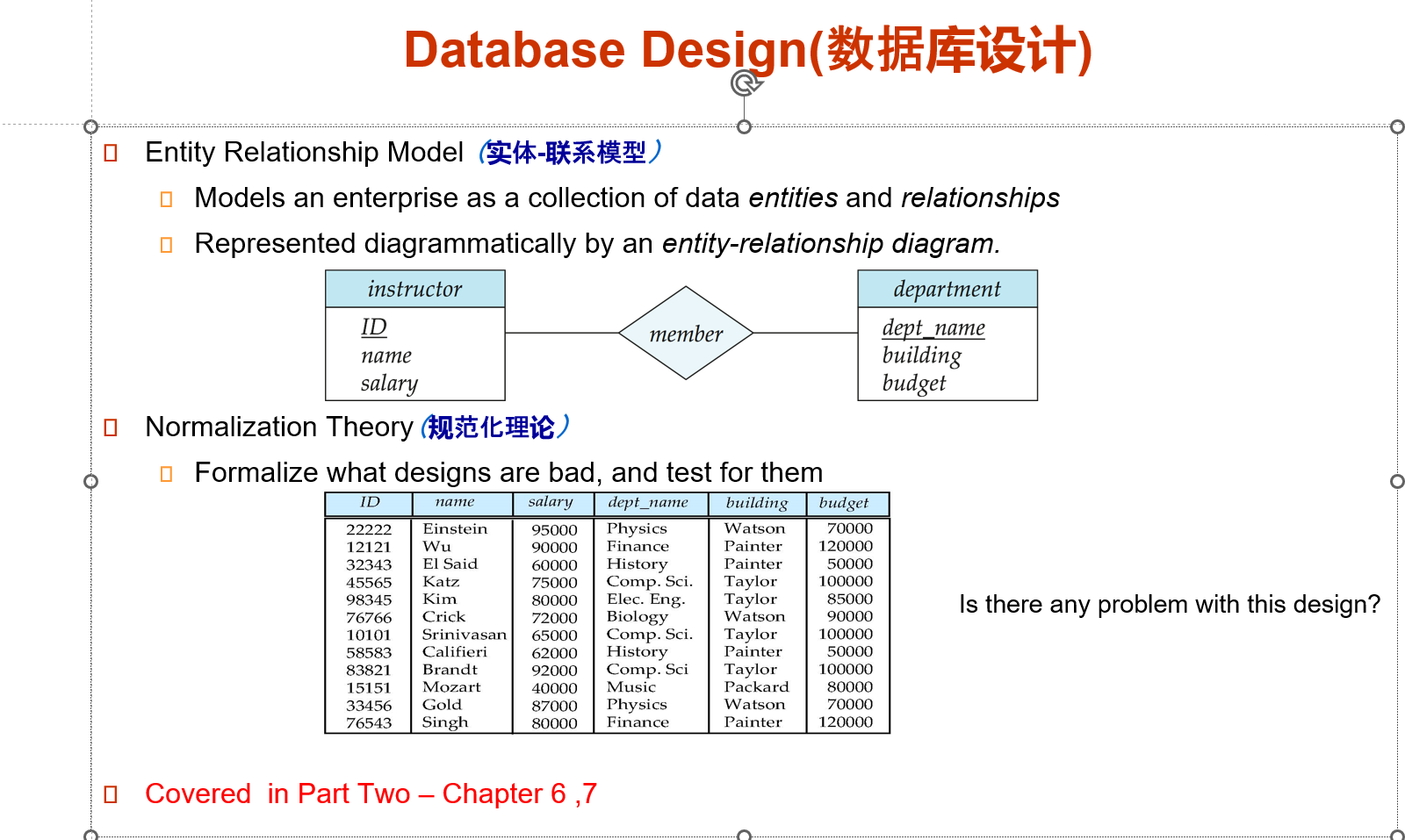
DataBase Engine¶
Abstract
- The storage manager
- The query processor
- The transaction management component.
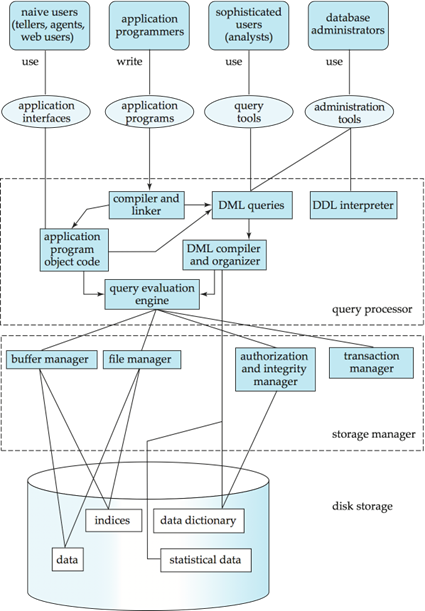
Storage Manager¶
- A program module that provides the interface between the low-level data stored in the database and the application programs and queries submitted to the system.
- The storage manager is responsible to the following tasks:
- Interaction with the OS file manager
- Efficient storing, retrieving and updating of data
- The storage manager components include:
- File manager
- Buffer manager
- Authorization and integrity manager
- Transaction manager
- Covered in Part five - Chapters 12 , 13, 14
- The storage manager implements several data structures as part of the physical system implementation:
- Data files -- store the database itself
- Data dictionary -- stores metadata about the structure of the database, in particular the schema of the database.
- Indices -- can provide fast access to data items. A database index provides pointers to those data items that hold a particular value.
- Statistical data
Query Processor¶
- The query processor components include:
- DDL interpreter -- interprets DDL statements and records the definitions in the data dictionary.
- DML compiler -- translates DML statements in a query language into an evaluation plan consisting of low-level instructions that the query evaluation engine understands.
- The DML compiler performs query optimization; that is, it picks the lowest cost evaluation plan from among the various alternatives.
- Query evaluation engine -- executes low-level instructions generated by the DML compiler.
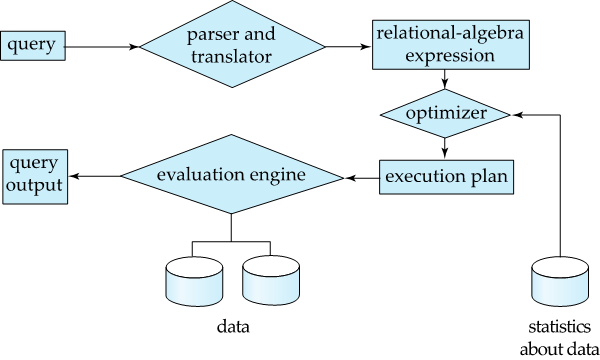
Transaction Management(事务管理)¶
- A transaction (事务)is a collection of operations that performs a single logical function in a database application.
- Recover Manager (恢复管理器)ensures that the database remains in a consistent (correct) state despite system failures (e.g., power failures and operating system crashes) and transaction failures.
- Concurrency-control manager(并发控制管理器) controls the interaction among the concurrent transactions, to ensure the consistency of the database.
Database Users¶

Turing Award¶
- Charles W. Bachman(1924-2017)
- Edgar F. Codd (1923-2003)
- Jim Gray(1944-2007)
- Michael Stonebraker (1943~ )